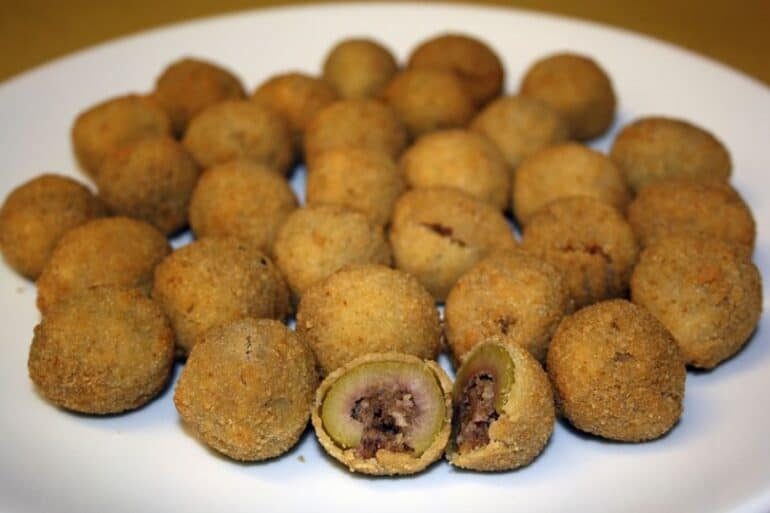Sewing your own clothes. Canning your own vegetables. Building your own furniture. All activities in the ‘why-on-earth-would-you’ realm. A lot of blood, sweat and tears just to proudly call something homemade. But really, is homemade always so much better than store-bought? One glance at that sweater your aunt gave you for Christmas and you know the answer.
So please be forewarned when you decide to make Olive Ascolane. After an entire afternoon spent making these stuffed and deep-fried olives, I was ready for the nuthouse. Granted, the result was magical. But how could it not have been? Hello! Chunky olives, different meats, cheese, breaded and… deep-fried!
The olives are originally from Ascoli Piceno, a province in the Marche region. They are now on pizzeria and trattoria menus in central Italy – including Rome. Served as an antipasto, they are perfect to take the edge off your hunger. But after my endeavor I will never again gobble up these olives when they arrive at the table. Instead, I’ll savor them. In fact, that might be the whole purpose of DIY – you experience how much effort goes into making (artisanal) items, so you’ll give them the attention they deserve. Yes, that’s even true for the funky sweater!
Olive Ascolane (recipe adapted from Giallo Zafferano)
A few things before you start. Use big green, tender, slightly salted olives (from Ascoli if you can). The best way to remove the pit is to take a small sharp knife and cut in a spiral movement, the way you peel an apple without breaking its skin. This way, the olive can be put back together without holes after you stuff them. This process definitely takes some practice!
• 750 grams green, meaty olives (Ascolane)
Ingredients for the stuffing:
- 2 tbsp olive oil
- 1 onion, chopped
- 1 carrot, chopped
- 1 small celery stalk, chopped
- 75 grams beef, ground or in chunks
- 75 grams ground pork, ground or in chunks
- 75 grams chicken or turkey, ground or in chunks
- 1 cup white wine
- 50 grams breadcrumbs
- 50 grams Parmigiano Reggiano
- 1 egg
- 1 handful of parsley, finely chopped
- rind of ½ lemon
- pinch of ground cloves
- pinch of nutmeg
For the breading:
- flour
- 3 eggs, lightly beaten
- breadcrumbs
- vegetable oil for frying
Heat the olive oil in a large pan and fry the onion over medium heat until soft and translucent. Add the carrot and celery and fry for another 5 minutes. Add the meat and brown thoroughly on all sides. Add salt to taste. Pour the wine in and reduce the heat. Simmer for 30 minutes.
In the mean time, remove the pits from the olives as described above.
Once the meat has cooled off, add it to a food processor and grind to a very fine
paste. In a bowl, combine the breadcrumbs, cheese, egg, parsley, lemon rind, cloves, nutmeg and meat paste to a consistent, smooth stuffing.
Stuff every olive with a tiny ball of meat paste and put it back in its original shape.
For the breading, dust every olive in flour, then dunk it into the egg mixture and
finish with a layer of breadcrumbs. For a thicker crust, you can repeat this process.
Add 5-7 centimeters of vegetable oil to a small frying pan and heat to 175-180 °C. Deep-fry the olives in small batches until golden brown. Transfer to a bowl lined with paper towels and serve, preferably piping hot.







a good one 🙂
I’ve searched for a long time to find the right recipe. This is close to what I grew-up with. My dad’s parents were both from Ascolii Piceno and we made these every year growing up in Philadelphia. My wife, kids and I visited there for the first time last summer (2012). We still have lots of family there and these olives are served at every restaurant and bar. Delicious! We did find them at a couple of places in Rome but they were weak imitations. Biggest problem making them at home (Chicago) is finding the Ascolane olives. I knew this recipe was legitimate when it said to peel the olive off the pit in a single spiral ribbon. That was my dad’s job and it’s what makes them authentic (to me). Of course, this is very difficult to do let alone master. I still ruin a lot of olives trying. Thanks for posting! I will pass this along to my siblings so we can keep the tradition going.
Hi Vincent, I am very happy to hear that you found the recipe useful! It’s a lot of work, but definitely worth it!